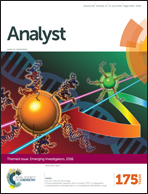Digital PCR using micropatterned superporous absorbent array chips†
Abstract
Digital PCR (dPCR) is an emerging technology for genetic analysis and clinical diagnostics. To facilitate the widespread application of dPCR, here we developed a new micropatterned superporous absorbent array chip (μSAAC) which consists of an array of microwells packed with highly porous agarose microbeads. The packed beads construct a hierarchically porous microgel which confers superior water adsorption capacity to enable spontaneous filling of PDMS microwells for fluid compartmentalization without the need of sophisticated microfluidic equipment and operation expertise. Using large λ-DNA as the model template, we validated the μSAAC for stochastic partitioning and quantitative digital detection of DNA molecules. Furthermore, as a proof-of-concept, we conducted dPCR detection and single-molecule sequencing of a mutation prevalent in blood cancer, the chromosomal translocation t(14;18), demonstrating the feasibility of the μSAAC for analysis of disease-associated mutations. These experiments were carried out using the standard molecular biology techniques and instruments. Because of its low cost, ease of fabrication, and equipment-free liquid partitioning, the μSAAC is readily adaptable to general lab settings, which could significantly facilitate the widespread application of dPCR technology in basic research and clinical practice.

- This article is part of the themed collection: Emerging Investigators

 Please wait while we load your content...
Please wait while we load your content...